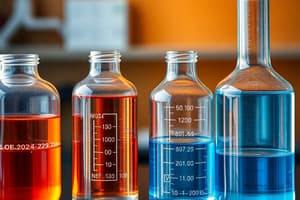Podcast
Questions and Answers
What is the characteristic of metals with standard reduction potential values near about – 2.0 volt or more?
What is the characteristic of metals with standard reduction potential values near about – 2.0 volt or more?
- They have high positive reduction potentials
- They are poor reducing agents
- They are strongly electropositive (correct)
- They are highly electronegative
What happens to the tendency of metals to liberate hydrogen gas from dilute acids as you descend in the electrochemical series?
What happens to the tendency of metals to liberate hydrogen gas from dilute acids as you descend in the electrochemical series?
- It becomes constant
- It remains the same
- It decreases (correct)
- It increases
Which of the following metals can liberate hydrogen from water?
Which of the following metals can liberate hydrogen from water?
- Iron and the metals above it (correct)
- Copper and metals above it
- Iron and metals below it
- Mercury and metals below it
What is the direction of the oxidation reaction in the equation Mn → Mn⁺⁺ + ne⁻?
What is the direction of the oxidation reaction in the equation Mn → Mn⁺⁺ + ne⁻?
What is the relationship between the reduction potential of a metal and its ability to displace hydrogen from dilute acids?
What is the relationship between the reduction potential of a metal and its ability to displace hydrogen from dilute acids?
What happens to the thermal stability of the oxide of a metal as you descend in the electrochemical series?
What happens to the thermal stability of the oxide of a metal as you descend in the electrochemical series?
What is the tendency of non-metals with high positive values of standard reduction potentials?
What is the tendency of non-metals with high positive values of standard reduction potentials?
Which of the following metals is a strong reducing agent?
Which of the following metals is a strong reducing agent?
What is the direction of the electrochemical series?
What is the direction of the electrochemical series?
What is the relationship between standard free energy change and cell potential?
What is the relationship between standard free energy change and cell potential?
Which of the following metals has a moderate electropositive character?
Which of the following metals has a moderate electropositive character?
What is the oxidation reaction in the electrochemical series?
What is the oxidation reaction in the electrochemical series?
Which of the following metals has a more negative reduction potential?
Which of the following metals has a more negative reduction potential?
What is the principle behind the extraction of metals like Ag and Au from their salt solutions?
What is the principle behind the extraction of metals like Ag and Au from their salt solutions?
Which of the following metals is NOT an alkali or alkaline earth metal?
Which of the following metals is NOT an alkali or alkaline earth metal?
What happens when metals below copper in the electrochemical series are heated?
What happens when metals below copper in the electrochemical series are heated?
Which of the following is a stronger reducing agent?
Which of the following is a stronger reducing agent?
What is the relationship between the reduction potential of a metal and its reducing power?
What is the relationship between the reduction potential of a metal and its reducing power?
What is the relationship between the electrochemical equivalent (Z) of an element and its equivalent weight (E)?
What is the relationship between the electrochemical equivalent (Z) of an element and its equivalent weight (E)?
What is the Faraday constant (F) equivalent to?
What is the Faraday constant (F) equivalent to?
How many moles of electrons are required to liberate one mole of monovalent cation?
How many moles of electrons are required to liberate one mole of monovalent cation?
What is the unit of Faraday constant (F)?
What is the unit of Faraday constant (F)?
What is the number of Faraday equivalent to?
What is the number of Faraday equivalent to?
What type of conductors are copper, silver, and tin?
What type of conductors are copper, silver, and tin?
What is the relationship between the mass of a substance deposited or liberated at an electrode and the quantity of electricity passed?
What is the relationship between the mass of a substance deposited or liberated at an electrode and the quantity of electricity passed?
What is the charge carried by one mole of electrons?
What is the charge carried by one mole of electrons?
What is the electrochemical equivalent (ECE) of an ion?
What is the electrochemical equivalent (ECE) of an ion?
What is the relationship between the amount of electricity involved in a reaction and the number of moles of electrons involved?
What is the relationship between the amount of electricity involved in a reaction and the number of moles of electrons involved?
What is the quantity of electricity involved in a reaction when one mole of electrons is involved?
What is the quantity of electricity involved in a reaction when one mole of electrons is involved?
What is the unit of electrochemical equivalent (ECE)?
What is the unit of electrochemical equivalent (ECE)?
What is the unit of electrochemical equivalent?
What is the unit of electrochemical equivalent?
What is the number of electrons in 1 mole of electrons?
What is the number of electrons in 1 mole of electrons?
What is the value of Faraday's constant in Coulombs?
What is the value of Faraday's constant in Coulombs?
What is the charge of one electron in Coulombs?
What is the charge of one electron in Coulombs?
What is the relationship between the amount of substance and the quantity of electricity passed in Faraday's law of electrolysis?
What is the relationship between the amount of substance and the quantity of electricity passed in Faraday's law of electrolysis?
Flashcards are hidden until you start studying




